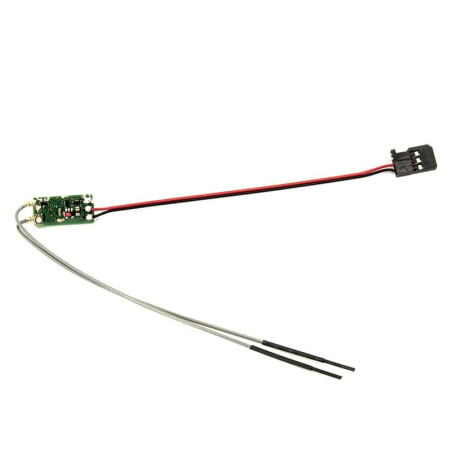


A miniature and very lightweight Futaba S-FHSS 2.4 GHz transmission system receiver without telemetry with a pair of full-range differential antennas. It is mainly designed for use in FPV drones and other models using control units communicating via S.BUS; due to its miniature size and very light weight, it is also suitable for small model aircraft with S.BUS/S.BUS2 servos. The R2000SBM provides one S.BUS serial output. The receiver's operating states are indicated by an LED.
Transmission system
Futaba S-FHSS 2.4GHz for flying models (for Futaba S-FHSS transmitters and TN-FH RF module).
Power supply
4.8-7.4 V (nominal voltage) - that is, e.g., 4-6 NiMH, 2S LiPo, LiFe, Li-ion batteries, BEC power stabilizers in a given voltage range.
Antenna
The receiver is equipped with a pair of differential antennas to maximize signal reception regardless of the relative position of the model and transmitter. They should be mounted on the model with a mutual orientation of 90°.
Receiver outputs
The receiver is equipped with a three-wire S.BUS output cable with a Futaba-type servo connector. The S.BUS output has a maximum of 8 channels.
Telemetry
The R2000SBM does not allow the transmission of telemetry data, but it does allow the transmission of received signal strength (RSSI) data to the drone's control unit.
What is S.BUS2/S.BUS
S.BUS - Futaba's serial bus with unidirectional communication that allows control of servos, controllers, switches, gyros and other compatible RC devices connected to a single output port of the S.BUS receiver.
S.BUS2 - Futaba's serial bus for bidirectional communication allowing (like S.BUS) control of servos, controllers, switches, gyroscopes and other compatible RC devices connected to one output/input port of the S.BUS2 receiver. In addition, it allows you to connect telemetry sensors and send data from them through the receiver for display on the transmitter; from some servos, the S.BUS2 can send information about operating current, temperature or servo output lever angle to the transmitter.
Unlike classic RC kits, the S.BUS(2) system uses serial data communication to send control signals from the receiver to the servo, gyro or other device. This data includes commands such as "move channel 3 servo by 15 degrees, move channel 5 servo by 30 degrees" for many devices. S.BUS(2) devices only execute commands belonging to their own set channel. For this reason, it is possible to connect several servos to the same signal cable, setting and controlling them individually as needed. The servo identification code (ID) is used for this purpose. You can find the ID on a sticker on the servo box.
The S.BUS2 servo can be connected to the receiver's S.BUS2 and S.BUS ports. Its function is determined by setting the channel in the servo's memory (this is done using the programming interface of the Futaba transmitter, the SBC-1 programmer or the CIU-3 USB interface with the S-Link PC program - for some servos, the channel can only be set using the transmitter).
An S.BUS or S.BUS2 servo connected to the channel output of a classic receiver (PWM) works like a classic servo. Its movement is indicated by a signal in the channel of the receiver to which it is connected. The settings of programmable servo functions remain in effect.
Specifications:
*Follow the instruction manual included with the product.